Female Greek Statues – Discover the Top Greek Statues of Women
The various goddesses worshipped in ancient Greek society were held in high regard, and therefore, we find many examples of female Greek statues. Aphrodite was the most revered deity because she symbolized grace and affection, but there were numerous others that the Greeks revered for a variety of reasons. Whereas other cultures largely valued masculine statues, the Greeks prominently exhibited the female form in countless Greek statues of women. Today, we will be looking at a few of the most important female Greek sculptures.
Famous Female Greek Statues
Greek women were not allowed to engage in the political activities of the Greek regions in ancient Greece, yet they were significantly essential in the household and anything linked to art or creativity. The Greek society of the Classical era were those that followed highly prized power, integrity, and bravery. However, it was clear from the mythology and female Greek sculptures that women were regarded highly, in a somewhat slightly different manner to men.
Here is our choice of the most important Greek statues of women.
The Phrasikleia Kore (c. 550 BC) by Aristion of Paros
| Sculptor | Aristion of Paros (c. 550 BC) |
| Date | c. 550 BC |
| Medium | Marble |
| Current Location | Museum of Acropolis, Athens, Greece |
Among the earliest Greek statues of women from ancient Greece was created as a funeral monument, which is akin to a contemporary headstone used by family members to commemorate the burial places of their relatives or friends. These burial sculptures were occasionally designed to look exactly like the female buried underneath them.
Historians estimate the artwork dates back to 550 BC.
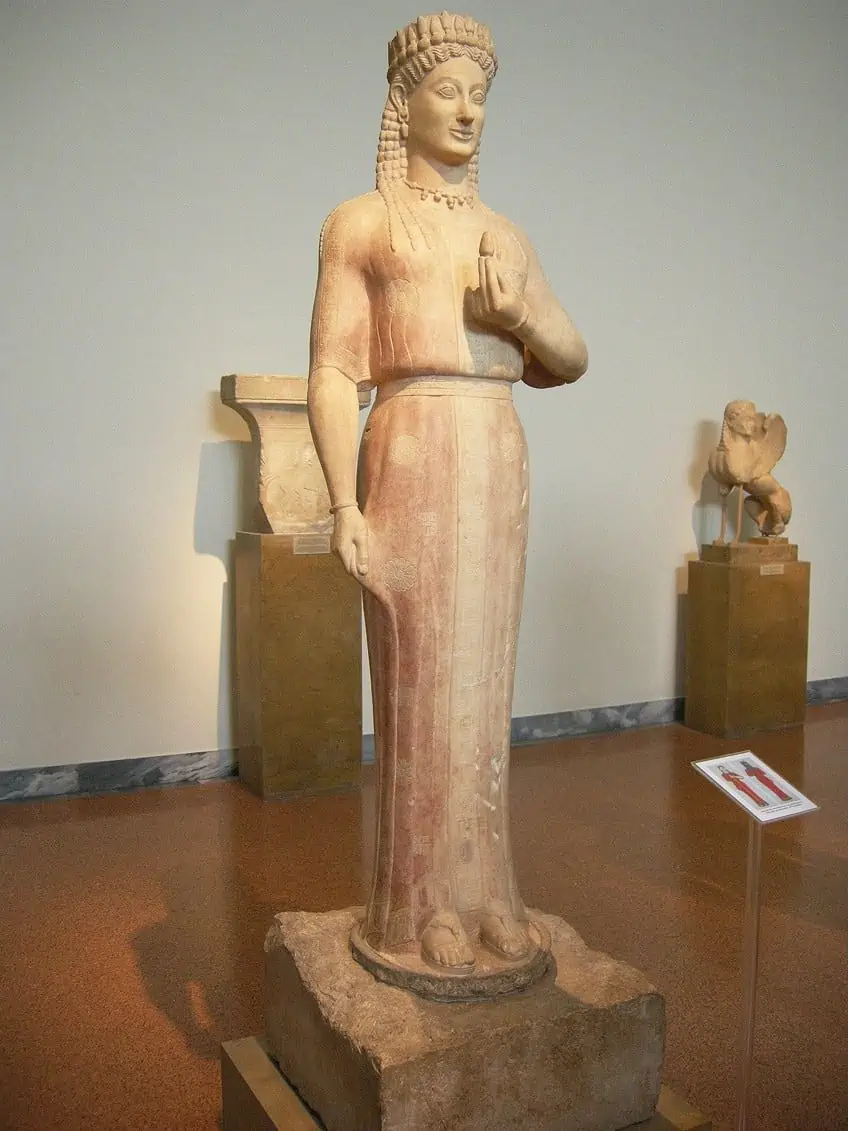
This sculpture is one of the best-preserved examples of its genre from ancient Greece. These burial monuments were only used when the female was not married. The top of the monument’s base bears a text that translates as: “Maiden I must be dubbed forever; rather than marriage, the Gods chose this name for me”.
Further inscriptions on the left-hand side of the figure’s base reveal that Aristion of Paros created it.
The Peplos Kore (c. 530 BC) by Unknown
| Sculptor | Unknown (c. 550 BC) |
| Date | c. 530 BC |
| Medium | Marble |
| Current Location | Archaic Acropolis Gallery, Athens, Greece |
One of the first Greek sculptures featuring a woman is said to be made around 530 BC. The Peplos Kore statue is a basic yet exquisite piece showing a youthful Greek girl. The white marble figure is approximately 46 inches tall, and there are indications that it was formerly lavishly painted.
The Peplos Kore, like many of the other great female Greek sculptures, would have been lost to history had researchers not unearthed it in 1886.

The statue was discovered in three fragments near the Erechtheion, which has subsequently been designated as a museum. The name of this sculpture comes from the figure of the girl and the garments she is wearing. Peplos was a term that referred to the style of clothing she wore, and kore means “girl” in the Greek language.
Athena Parthenos (c. 5th Century) by Phidias
| Sculptor | Phidias (c. 5th century) |
| Date | (c. 5th century) |
| Medium | Chryselephantine |
| Current Location | Destroyed |
During the Classical Greek and Hellenistic eras, Athena was regarded as the ruler of all Greek deities, and she was frequently depicted in sculptures and paintings. It is among the most renowned Greek statues of women ever created.
Regrettably, the sculpture was lost when Greece was overrun by hostile troops, and the majority of their most prized artworks and other important objects were either lost, stolen, or destroyed.
The famous statue is also called Athena the Virgin. The original piece is believed to have been composed of ivory and gold but several reproductions fabricated from marble and other substances such as bronze remain. We know about the sculpture as it was described in detail by ancient authors like Pausanias, who reported that it stood around eight feet tall.
Diana of Gabii (c. 4th Century BC) by Praxiteles
| Sculptor | Praxiteles (c. 4th century BC) |
| Date | c. 4th century BC |
| Medium | Marble |
| Current Location | The Louvre Museum, Paris, France |
Praxiteles is perhaps the most renowned Greek sculptor in art history, having produced many of the most recognized sculptures throughout the ancient culture’s reign over specific portions of the upper Mediterranean Sea. He flourished in the fourth century BC and is said to be the very first sculptor to make a sculpture of a naked female body. Diana of Gabii is one of his most well-regarded masterpieces.
This life-sized statue is most likely a portrayal of the Greek deity Artemis, who was associated with the forest, hunting, and virginity.
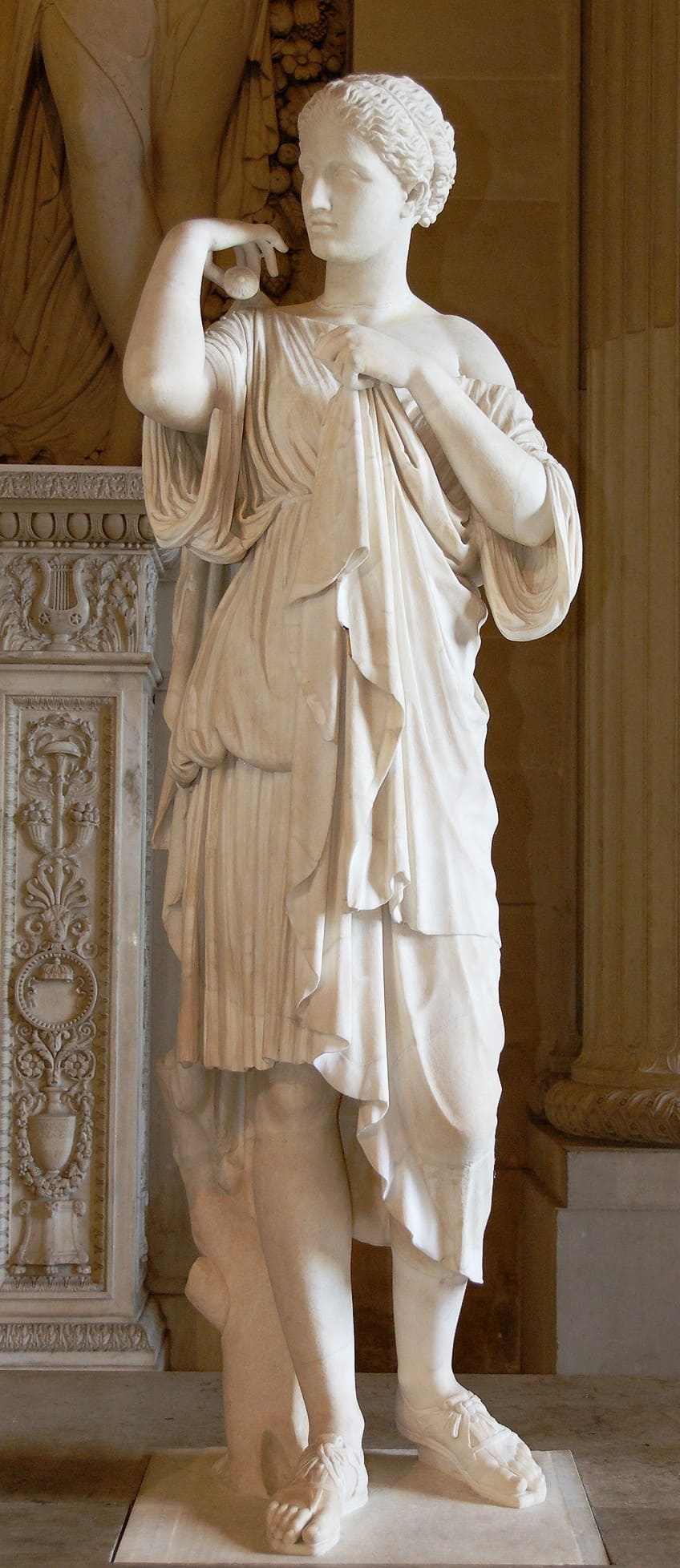
Praxiteles most likely opted to show the deity completely clad due to her reputation for purity. A Scottish artist named Gavin Hamilton, with a penchant for unearthing old artwork lost by history, uncovered the sculpture. Hamilton was reputed to have discovered several spectacular antique works, such as this one, which he discovered in 1792 at Gabii, a city near Rome.
Aphrodite of Knidos (c. 4th Century BC) by Praxiteles
| Sculptor | Praxiteles (c. 4th century BC) |
| Date | c. 4th century BC |
| Medium | Marble |
| Current Location | Louvre Museum, Paris, France |
Another notable statue produced by the Greek sculptor Praxiteles is one of the most renowned female Greek statues still in existence today. The piece is named Aphrodite of Knidos, and it has been estimated to have been produced in about the 4th century BC.
It is also believed to be one of the first depictions of the naked woman’s body by a sculptor from Greece, and the statue is remarkably life-like.

It’s designed to honor Aphrodite, the Greek deity of beauty and love, but it’s possible that the piece was received with some hostility at the time because other sculptors normally depicted women as partially or dressed. Aphrodite is seen entirely naked, concealing her genital area with one of her hands and clutching a robe with the other.
The original sculpture has now been lost; however, the sculpture has been reproduced several times by Roman artists and others over the centuries.
Caryatids of Erechtheion (c. 420 BC) by Unknown
| Sculptor | Unknown (c. 420 BC) |
| Date | c. 420 BC |
| Medium | Marble |
| Current Location | British Museum, London, United Kingdom |
The Acropolis of Athens was among ancient Greece’s most significant monuments. It was a large temple on a craggy mountaintop situated overlooking Athens, and it is regarded as an architectural masterpiece. According to Greek tradition and religion, one of the most important elements of this vast temple was the Erechtheion, a smaller component positioned on the structure’s rear.
Instead of regular columns, the Erechtheion’s roof was upheld by Caryatids, which were Greek statues of women positioned where columns would ordinarily be employed to carry the weight of the roof.
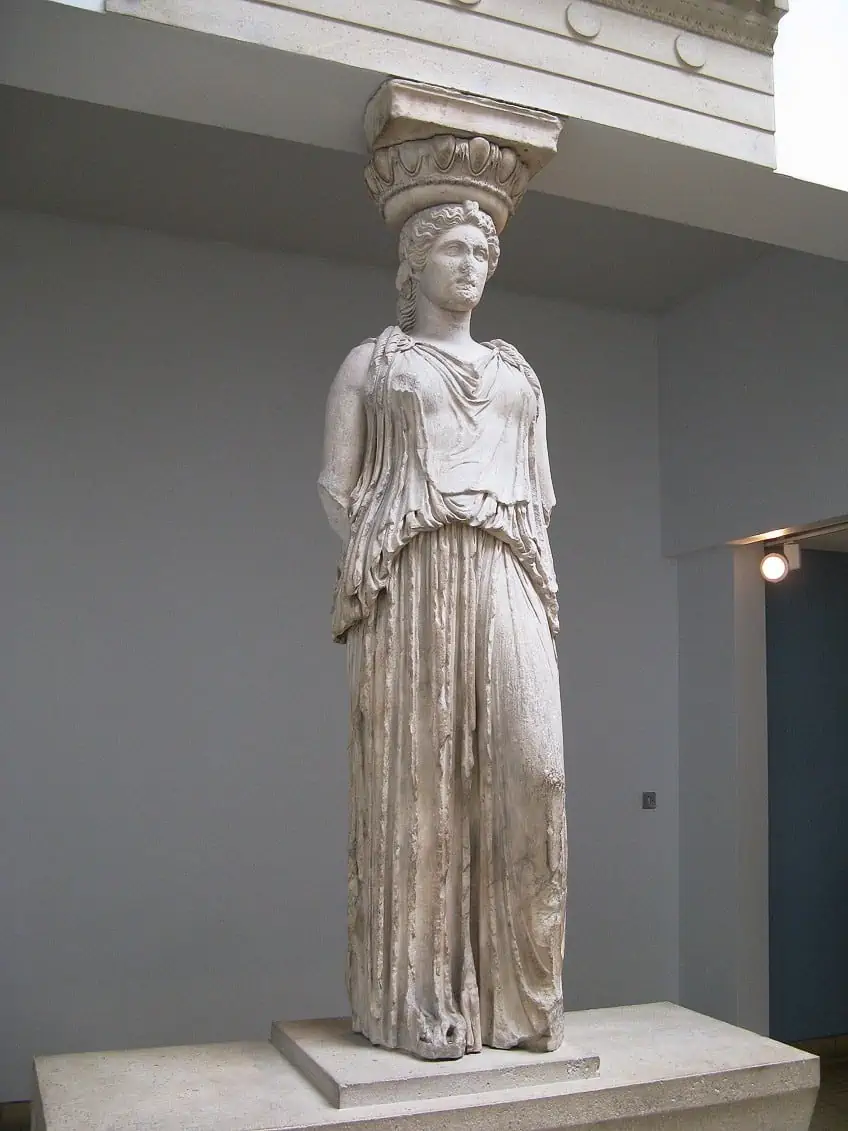
Five Caryatids have survived to the modern era. These one-of-a-kind figures were carved from Pentelic marble and are dressed in extravagant garments with beautiful, braided hair. The Caryatids are depicted with the majority of their weight resting on the right leg while the other leg is somewhat bent in each of these female Greek sculptures.
Varvakeion Athena (c. 3rd century BC) by Phidias
| Sculptor | Phidias (c. 3rd century BC) |
| Date | c. 3rd century BC |
| Medium | Chryselephantine |
| Current Location | National Archaeological Museum of Athens, Athens, Greece |
Greco-Roman sculptors were credited for a multitude of replicas and replicas of notable female Greek statues from both the Classical and Hellenistic ages. Some of these sculptures have survived to the present day, but the vast majority have been stolen or destroyed.
One of the most often copied works from antiquity was the Athena Parthenos, whose original was lost at some point when foreign invaders ravaged and conquered Greek territory.

Archaeologists almost unanimously believe that the most stunning duplicate of this iconic masterpiece that remains today is Varvakeion Athena. The sculpture is not quite as massive as the original, being just around 41 inches tall, while the original was about 8 feet tall.
The meticulous craftsmanship in this statue, though, makes it more valuable than any other duplicate of the same piece.
Diana of Ephesus (c. 2nd Century) by Unknown
| Sculptor | Unknown (c. 2nd century) |
| Date | c. 2nd century |
| Medium | Alabaster |
| Current Location | Ephesus Archaeological Museum, Turkey |
Feminists have been looking for proof of formidable goddesses and a period when the feminine essence was dominant. They simply need to go to Turkey, where it took on its most grandiose, unmistakable, and important form in Ephesus. Diana of Ephesus was the twin sibling of Apollo as well as the daughter of Jupiter, the supreme deity, and Latona.
Latona went into labor with Diana painlessly and then assisted her mother in the delivery of Apollo.
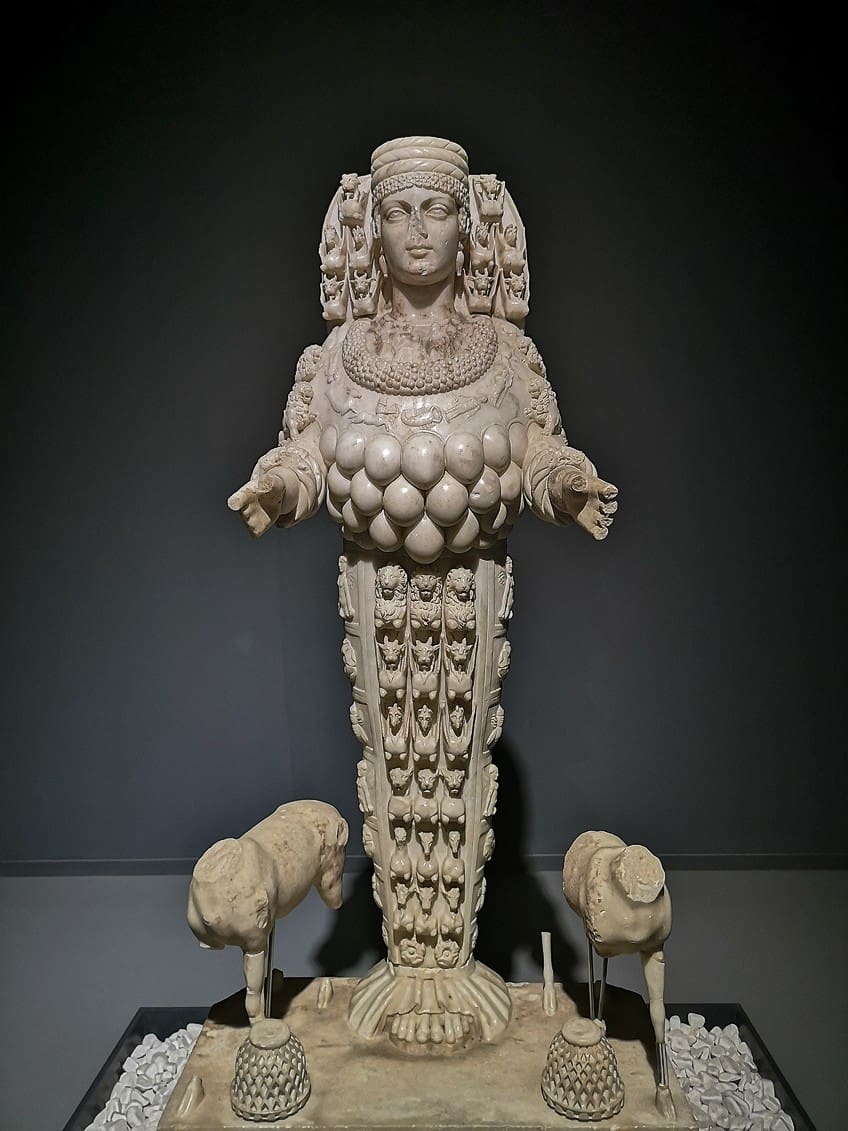
When her father inquired her what she wanted as a present, she said perpetual virginity. Her statue is one of the most prominent Greek statues of women in Greece, depicting Diana wearing a saffron robe and surrounded by nine nymphs.
Diana is also referred to as the deity of nature, the underworld, and the moon.
Winged Victory of Samothrace (190 BC) by Unknown
| Sculptor | Unknown (c. 220 BC) |
| Date | 190 BC |
| Medium | Parian marble |
| Current Location | Louvre Museum, Paris, France |
The sculpture, also known as Nike, is one of the most revered and renowned female Greek statues. It is regarded as one of the best artworks from the Greek Hellenistic era. Archaeologists think this work was produced in the second century BC.
Created from Parian marble, it was almost completely forgotten about until it was unearthed during an excavation in 1863 on the island of Samothrace.
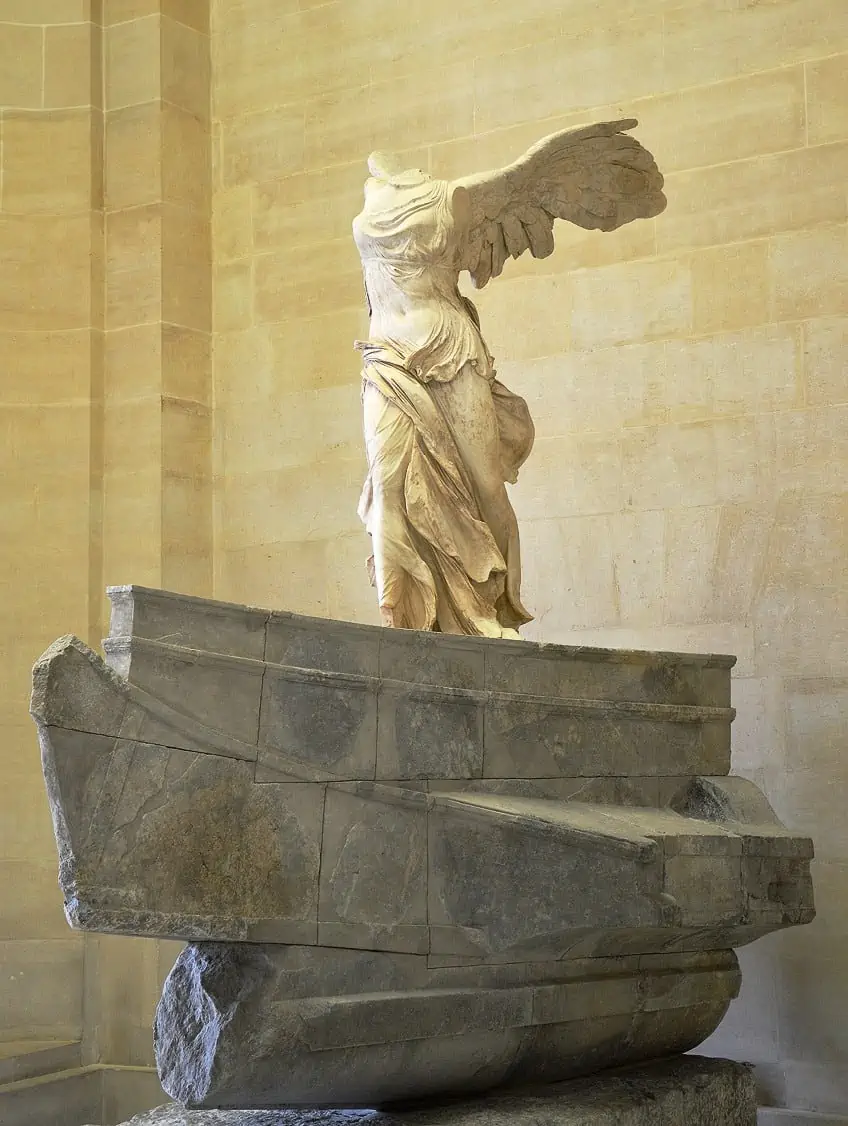
Several historians who have analyzed the magnificent sculpture believe it was produced to memorialize a massive battle that occurred in the second century BC. Though her head is missing, the sculpture still has large, elaborate wings that are oriented backward, as if the deity were getting ready to fly off.
Venus de Milo (c. 125 BC) by Alexandros of Antioch
| Sculptor | Alexandros of Antioch (c. 130 BC) |
| Date | c. 125 BC |
| Medium | Marble |
| Current Location | Louvre Museum, Paris, France |
On the Greek island of Milos around 1820, a poor farmer found one of the most recognized female statues of ancient Greece. The artwork was found and bought by the Marquis de Rivière, the French ambassador to Greece, who later presented it to King Louis XVIII. Just two years after it was found on the little Greek island, the statue was placed in the Louvre Museum in Paris.
Although this sculpture has been given numerous other names by academics, Venus de Milo is its most well-known moniker. This is one of the more recognizable works from ancient Greece because both arms are missing.

Although the sculpture includes an engraving with the name Venus, the Roman name for the same deity, it is believed to be a representation of Aphrodite. In contrast to many of the more well-known pieces discovered in recent years, this work is not a copy and is likely the original. It’s one of the more striking pieces from that era because of the exquisite detail in her shape and the shawl that covers her lower half.
Men initially created Greek sculptures, and the majority of the gods were male. Females had once had some degree of influence, and a few of them had such immense and enduring power that they were even used as models for ancient artifacts. It is said that mother goddesses ruled Greece until late in the 2nd century BC, when the Dorians conquered and established Apollo and Zeus as their major gods.
Take a look at our Greek Goddess statues webstory here!
Frequently Asked Questions
Why Were There Female Greek Sculptures?
The Greeks had many gods. At one point, many of them were female, and to revere them, sculptors created magnificent Greek statues of women that they viewed as deities. These deities were often associated with characteristics such as love, family, and nature.
Where Are the Most Famous Female Greek Statues Now?
Unfortunately, many of the female Greek sculptures were lost or destroyed after invaders entered Greece. However, there were many replicas produced based on descriptions and sketches of these famous artworks. Many of these wonderful sculptures can be found in museums in Greece, as well as all around the world.
Jordan Anthony is a Cape Town-based film photographer, curator, and arts writer. She holds a Bachelor of Art in Fine Arts from the University of the Witwatersrand, Johannesburg, where she explored themes like healing, identity, dreams, and intuitive creation in her Contemporary art practice. Jordan has collaborated with various local art institutions, including the KZNSA Gallery in Durban, the Turbine Art Fair, and the Wits Art Museum. Her photography focuses on abstract color manipulations, portraiture, candid shots, and urban landscapes. She’s intrigued by philosophy, memory, and esotericism, drawing inspiration from Surrealism, Fluxus, and ancient civilizations, as well as childhood influences and found objects. Jordan is working for artfilemagazine since 2022 and writes blog posts about art history and photography.
Learn more about Jordan Anthony and about us.
Cite this Article
Jordan, Anthony, “Female Greek Statues – Discover the Top Greek Statues of Women.” artfilemagazine – Your Online Art Source. October 31, 2022. URL: https://artfilemagazine.com/female-greek-statues/
Anthony, J. (2022, 31 October). Female Greek Statues – Discover the Top Greek Statues of Women. artfilemagazine – Your Online Art Source. https://artfilemagazine.com/female-greek-statues/
Anthony, Jordan. “Female Greek Statues – Discover the Top Greek Statues of Women.” artfilemagazine – Your Online Art Source, October 31, 2022. https://artfilemagazine.com/female-greek-statues/.



